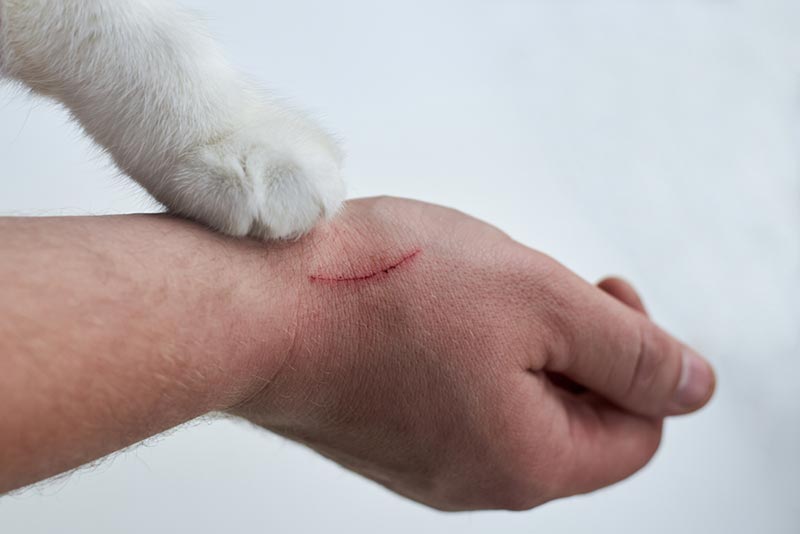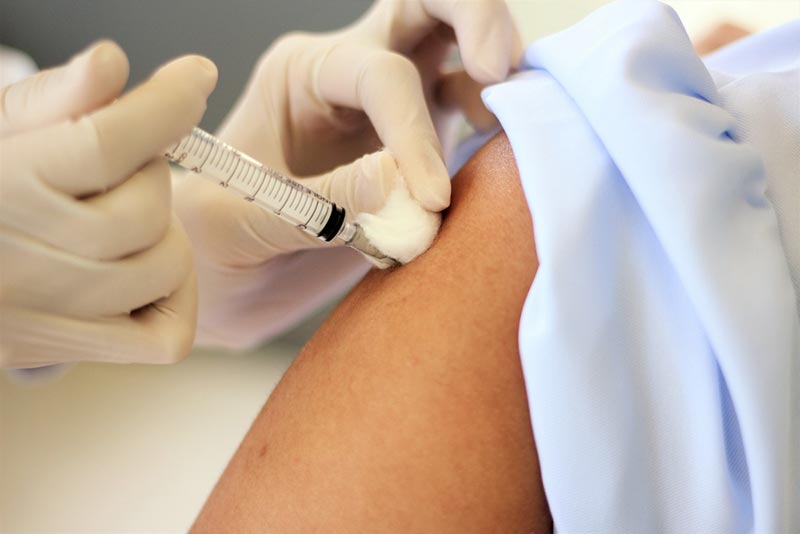Can You Get Rabies From a Cat Scratch? Vet-Approved Signs, Prevention, & FAQ
Updated on

Everyone has likely heard of rabies, particularly if you’re familiar with the films Old Yeller and Cujo. It’s a highly transmissible yet preventable disease often associated with dogs. However, it is just as likely to infect cats. The most typical way to become infected with rabies is by being bitten by an infected animal. But can you get rabies from a cat scratch?
It is technically possible, though this is a rare occurrence. Rabies is transmitted from an infected animal’s saliva, so the most common method of transmission is through a bite. In this article, we’ll discuss the symptoms to watch for and whether there is any treatment for rabies.
About Rabies

Rabies is a highly infectious viral disease that can infect mammals, which includes pets. The virus is also zoonotic and can be transmitted from animals to humans. Unfortunately, once the signs start to show, it is considered 100% fatal¹.
It is found worldwide but isn’t present in a few continents and countries, including the United Kingdom, the Pacific Islands, Japan, New Zealand, Australia, Antarctica, Ireland, Iceland, and a few parts of Scandinavia.
Cause of Rabies
The most common method of contracting the rabies virus is through a bite. Saliva that carries the virus is injected into the animal (or person) through the bite. Since saliva is the carrier of the disease, it helps explain why it’s rare for rabies to be passed on any other way.
However, it is possible to become infected if the saliva comes into contact with a scratch, open wounds, or mucous membranes, such as the mouth, nose, or eyes. Although it’s unlikely to become infected by a cat scratch, it’s possible. Since cats lick their paws, their saliva can be transferred to the scratch, which might lead to an infection.
What Animals Tend to Transmit Rabies?
This depends on the location; in Europe, it is usually foxes. In North America, raccoons, skunks, bats, foxes, and coyotes (usually in that order) can carry the disease. In Asia, Africa, and Latin America, stray dogs are the most common carriers of rabies. Human fatalities from the disease are also highest in those areas.
In the U.S., the bat is the primary cause¹ of human fatalities. The bite can be as small as a hypodermic needle, so in many cases, people don’t realize that they’ve been bitten. Worldwide, dogs¹ are the primary source of human fatalities from rabies.
After the person or animal is bitten, the saliva travels from the point of entry and moves along the nerves until it reaches the brain. From the brain, it enters the salivary glands, which is why saliva is the cause of infection. But before the rabies reaches the brain, there is an incubation period.

The Incubation Period
There is an incubation period from the time of the bite until the signs appear. For humans, it can be as short as 4 days or last for more than a year, sometimes as long as 2 years. However, the average incubation period is 3 to 8 weeks.
How long incubation takes depends on a few factors:
- How severe the bite or scratch is
- Where the wound is on the body—the closer the wound is to the spinal cord or brain, the faster the virus reaches the brain
- The type of rabies virus and how much of the virus was injected into the wound. There are times when the rabies virus isn’t always present in the saliva, or only a tiny amount of the virus enters the body
- Any existing immunity
There aren’t any signs during the incubation period, which means the animal isn’t contagious. The signs will appear once rabies reaches the brain and salivary glands, and the animal is contagious.
What Are the Signs of Rabies in Humans?
Rabies has two stages for humans once the incubation period has ended and the infection has reached the brain.
Stage 1
This stage can last about 2 to 10 days.
The signs are similar to those of the seasonal flu:
- Headache
- Fever
- Lack of appetite
- Vomiting
- Generally feeling unwell (malaise)
These signs are at the site of the wound:
- Itching
- Pain
- Numbness
- Tingling

Stage 2
Stage 2 is the final stage and lasts 2 to 10 days.
The signs are quite severe at this point:
- Difficulty swallowing (this can lead to foaming at the mouth)
- Hydrophobia (fear of water)
- Disorientation and confusion
- Agitation and anxiety
- Delirium and hallucinations
- Insomnia
- Possibly becoming paralyzed
- Coma
- Death
Once the symptoms begin, the disease is almost always fatal, and there is no treatment. There has been the occasional survivor, but that is quite rare.
What Are Common Rabies Signs in Animals?
Animals have similar signs as humans. The first stage is also called the prodromal phase, and the first noticeable sign is a change in temperament. If your cat is shy, they become agitated and hyper, and if they are outgoing, they become reclusive and nervous.
The other signs listed in Stage 1 for people are similar to what you’ll see in an animal. The prodromal phase usually lasts about 2 to 3 days. Once the prodromal phase is over, there are two final stages, and cats will either show one of these or a combination of both.
Dumb or Paralytic Rabies
This phase is one of the more common stages:
- Gradual paralysis
- Difficulty swallowing
- Foaming at the mouth
- Excessive salivation
- Incoordination
- Distortion of the face
- Difficulty breathing
- Seizures

Furious Rabies
This is the phase that we strongly associate with rabies, in which the cat becomes aggressive:
- Nervous
- Irritable
- Aggressive
- Excitable
- Inability to drink or eat
- Gradual paralysis
- Hypersensitive to light and sound
- Seizures
The first phase only starts when the virus has reached the brain. From that point, the animal typically dies within 7 days.
Is There Treatment?
Once the signs are apparent, there is no treatment for humans or animals. However, medical attention once the bite or scratch has occurred can provide immunity. Dogs and cats should receive a rabies vaccine followed by an annual rabies booster, which provides immunity. They will receive another shot after exposure.
The original rabies shots that humans had to get after rabies exposure involved several needles in the stomach. Today, however, rabies shots go into the upper arm, making for much less painful treatment.

Can Rabies Be Diagnosed?
Unfortunately for animals, there is no diagnosis except for the signs toward the end. If a wild animal or any animal acting erratically bites your pet, take them to the vet straightaway for the shot. The only way to get an official diagnosis is to examine the brain tissue after the animal has died.
In humans, saliva, serum, and spinal fluid samples can be tested, as can a skin biopsy from the nape of the neck. However, none of these tests can absolutely determine a rabies diagnosis.
Report to the Authorities
Whether you or your pet were bitten or not, you should report it to your local health department. Stay clear if you see an animal acting erratically, particularly if it’s a wild animal that approaches you. Be sure to get your pet out of harm’s way.
Conclusion
While getting rabies from a cat scratch isn’t that common, it’s a possibility, and it’s always best to err on the side of caution and get checked out, particularly if the cat seems unwell. If you work in a field that frequently deals with animals, it’s recommended that you speak to your doctor and stay up to date with your rabies vaccine.
Always keep your pets up to date on their vaccines, too. In many states and provinces, it’s mandatory that your dogs and cats get their rabies booster, which not only ensures their safety but also yours.
See also:
- What Kind of Dog Was Old Yeller? Famous Dogs Facts & FAQ
- What Kind of Dog Was Cujo? Famous Dogs Presented
Featured Image Credit:













